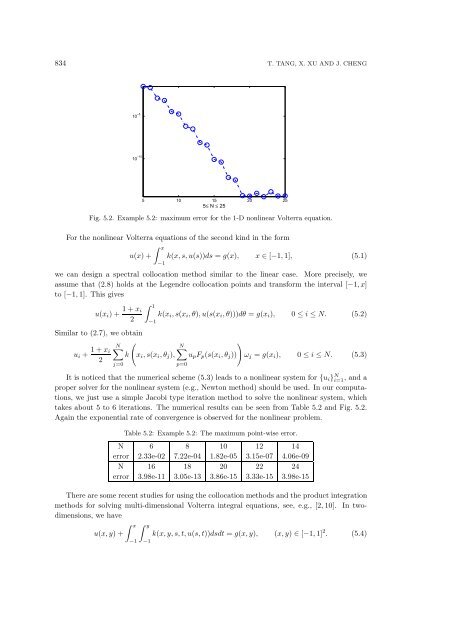On Spectral Methods for Volterra Type Integral Equations and the ...
On Spectral Methods for Volterra Type Integral Equations and the ...
On Spectral Methods for Volterra Type Integral Equations and the ...
You also want an ePaper? Increase the reach of your titles
YUMPU automatically turns print PDFs into web optimized ePapers that Google loves.
834 T. TANG, X. XU AND J. CHENG<br />
10 −5<br />
10 −10<br />
5≤ N ≤ 25<br />
5 10 15 20 25<br />
Fig. 5.2. Example 5.2: maximum error <strong>for</strong> <strong>the</strong> 1-D nonlinear <strong>Volterra</strong> equation.<br />
For <strong>the</strong> nonlinear <strong>Volterra</strong> equations of <strong>the</strong> second kind in <strong>the</strong> <strong>for</strong>m<br />
u(x) +<br />
∫ x<br />
−1<br />
k(x, s, u(s))ds = g(x), x ∈ [−1, 1], (5.1)<br />
we can design a spectral collocation method similar to <strong>the</strong> linear case. More precisely, we<br />
assume that (2.8) holds at <strong>the</strong> Legendre collocation points <strong>and</strong> trans<strong>for</strong>m <strong>the</strong> interval [−1, x]<br />
to [−1, 1]. This gives<br />
u(x i ) + 1 + x i<br />
2<br />
j=0<br />
∫ 1<br />
−1<br />
k(x i , s(x i , θ), u(s(x i , θ)))dθ = g(x i ), 0 ≤ i ≤ N. (5.2)<br />
Similar to (2.7), we obtain<br />
(<br />
)<br />
u i + 1 + x N∑<br />
N∑<br />
i<br />
k x i , s(x i , θ j ), u p F p (s(x i , θ j )) ω j = g(x i ), 0 ≤ i ≤ N. (5.3)<br />
2<br />
p=0<br />
It is noticed that <strong>the</strong> numerical scheme (5.3) leads to a nonlinear system <strong>for</strong> {u i } N i=1 , <strong>and</strong> a<br />
proper solver <strong>for</strong> <strong>the</strong> nonlinear system (e.g., Newton method) should be used. In our computations,<br />
we just use a simple Jacobi type iteration method to solve <strong>the</strong> nonlinear system, which<br />
takes about 5 to 6 iterations. The numerical results can be seen from Table 5.2 <strong>and</strong> Fig. 5.2.<br />
Again <strong>the</strong> exponential rate of convergence is observed <strong>for</strong> <strong>the</strong> nonlinear problem.<br />
Table 5.2: Example 5.2: The maximum point-wise error.<br />
N 6 8 10 12 14<br />
error 2.33e-02 7.22e-04 1.82e-05 3.15e-07 4.06e-09<br />
N 16 18 20 22 24<br />
error 3.98e-11 3.05e-13 3.86e-15 3.33e-15 3.98e-15<br />
There are some recent studies <strong>for</strong> using <strong>the</strong> collocation methods <strong>and</strong> <strong>the</strong> product integration<br />
methods <strong>for</strong> solving multi-dimensional <strong>Volterra</strong> integral equations, see, e.g., [2, 10]. In twodimensions,<br />
we have<br />
u(x, y) +<br />
∫ x ∫ y<br />
−1<br />
−1<br />
k(x, y, s, t, u(s, t))dsdt = g(x, y), (x, y) ∈ [−1, 1] 2 . (5.4)

















